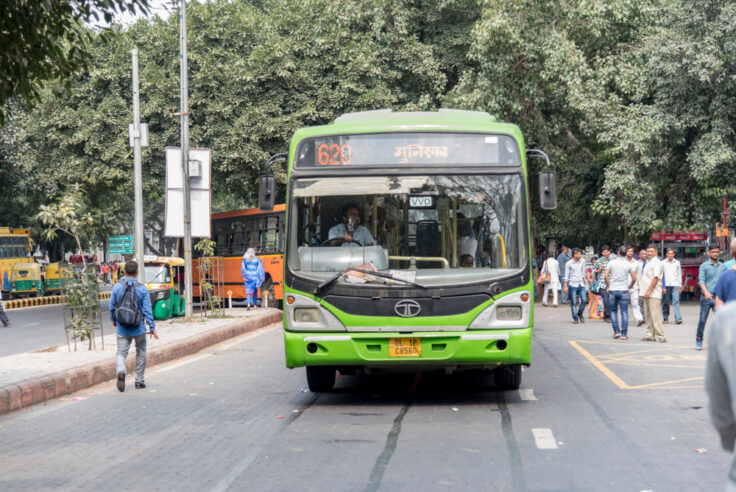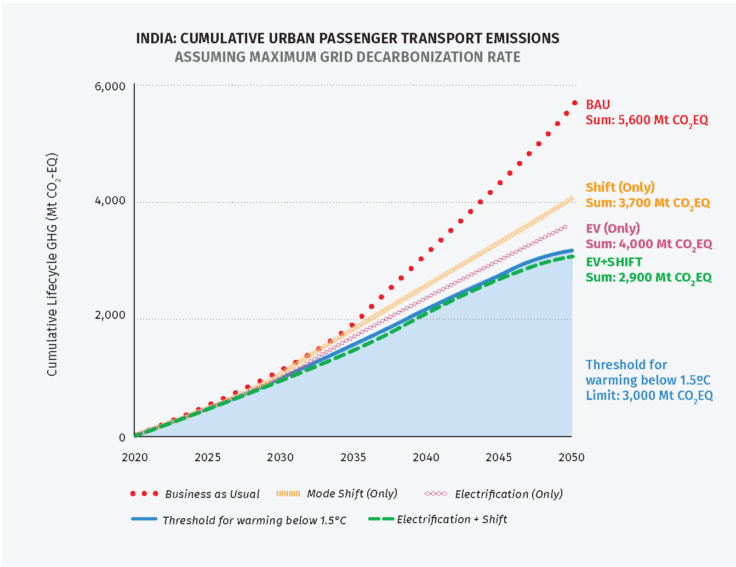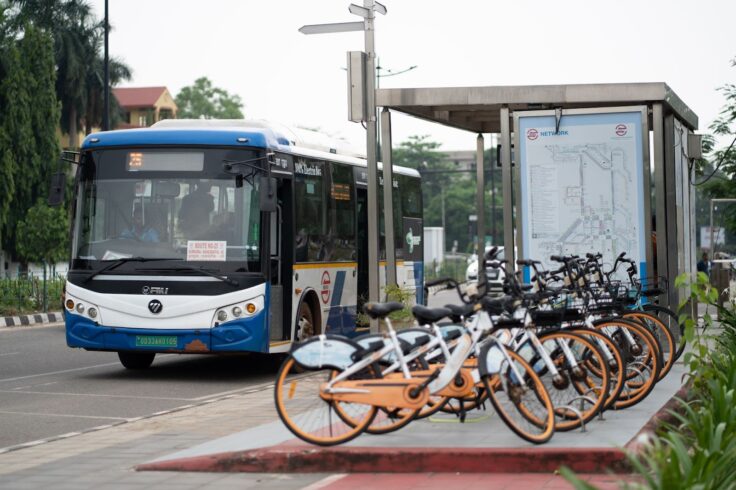April 10, 2024
India Needs More Compact, Electrified Cities to Meet Climate Goals
A version of this article was originally published in the No. 35 issue of the Sustainable Transport Magazine. Read it here.
By Keshav Suryanarayanan, ITDP India, and Jacob Mason, ITDP Global
Imagine a computer system that can only be activated with a key — but that key comes in two halves. Only bringing both keys together can make the system work. Each half-key is important, but each is insufficient-remember this image. In 2021, ITDP and the University of California, Davis (UC Davis) released The Compact City Scenario—Electrified report with critical research demonstrating a similar scenario for the future of our urban transport sectors.
Cities worldwide have two strategies available to decarbonize their transport sectors, but neither alone will be sufficient to address the impacts of climate change. One approach is extensive vehicle electrification across all modes, and the other is creating compact cities that minimize excess travel while encouraging a shift to walking, cycling, and public transport. Both strategies are important, but neither can have a sufficient impact on its own. These strategies are the two half-keys to unlock a future of sustainable, low-carbon cities. ITDP–UC Davis’ research involved modeling four scenarios of growth in passenger transport and resulting emissions:
ITDP–UC Davis’ research involved modeling four scenarios of growth in passenger transport and resulting emissions:
- Business-as-Usual (BaU): Cities continue with past trends and current policies.
- High Shift: Cities embrace compact land use and make walking, cycling, and public transport a priority.
- High Electrification: Cities pursue vehicle electrification intensively.
- Electrification + Shift: Cities combine the High Electrification and High Shift strategies.

The research ultimately finds that neither High Shift nor High Electrification can reduce emissions to limit global warming within 1.5°C — rather, the world needs both approaches combined. To assess the future of urban transport in high- emissions regions like India, ITDP and UC Davis recently developed the Compact Electrified Cities: India report to evaluate the potential of Electrification + Shift to help India achieve net zero emissions by 2070. Electrification + Shift would reduce national emissions and promote resilient, equitable, and healthier cities for all Indians.
A 2023 Air Quality Life Index Report estimates that, since 2013, 59% of the world’s growth in air pollution has come from India. Transport is the primary driver of these emissions, accounting for roughly a tenth of national emissions. Road transport makes up an alarming 90% off this figure, with the number off vehicles on India’s roads increasing four-fold since the early 2000s. However, cities continue to prioritize motor vehicles and are not adequately addressing unsafe conditions for walking and cycling and a lack of high-quality public transport.
The United Nations projects that, between 2020 and 2050, India’s urban population will nearly double to 877 million. This means that half of these future urban areas in India will be newly built and developed over the next 30 years. The country must take more action now to reduce vehicle emissions and improve sustainable mobility in its cities. Planners and policymakers cannot continue the same unsustainable urban growth and development models. Designing and creating infrastructure that prioritizes compact, mixed-use planning and electric transport will help ensure that India meets its climate commitments, produces significant economic savings, increases road safety, lowers congestion, and enhances quality-of-life.
The Compact Cities Electrified: India report finds that only compact planning and electrification together can effectively limit the country’s transport-related emissions.

How India Can Benefit from Compact, Electric Cities
Compared with a BaU scenario, Electrification + Shift would require significant investments into walking, cycling, and public transport infrastructure. While the upfront costs may be high, they will be more than balanced by the savings offered by decreasing car-centric road and highway development. In fact, the report suggests that over the next 30 years, an Electrification + Shift scenario could result in cumulative savings of over INR 400 trillion ($5 trillion USD). Of this, at least INR 150 trillion ($1.8 trillion USD) could be saved by national and local governments, which can be invested in other services like healthcare, housing, and education.
Even a High Electrification scenario would represent a major reduction in total energy consumption relative to BaU, because electric vehicles are much more efficient per kilometer than traditional vehicles. However, while total energy consumption would reduce, it would also result in an increase in the use of electricity. The focus on mode shift in an Electrification + Shift scenario that also prioritizes walking and cycling could reduce electricity consumption by almost a third, which would free up energy for the public and other uses. In addition to economic savings and lower energy demand, Electrification + Shift would create denser cities with more equitable transport, improving people’s access to opportunities for education, employment, leisure, and cleaner air.

What Else Do India’s Cities Need?
To achieve this future, India must enact policies at all levels to reallocate street space and transport funding from car infrastructure in favor of walking, cycling, and public transport. Simultaneously, the country can take more supportive actions, such as fee-rebate systems for electric vehicles, expanded public charging infrastructure, and improved emissions regulations. The report offers seven goals as part of achieving Electrification + Shift:
- Cities are compact and reachable;
- Every citizen gets a fair share of road space; Walking and cycling are attractive;
- Public transport is accessible and affordable; Everyone breathes clean air;
- Cities embrace green mobility;
- Everyone moves around the city seamlessly.
While the scale of such transformations would be immense, it is also not unprecedented. Paris, France decreased car travel by almost 50% in 30 years by investing in modes like cycling and traffic control strategies. Cities like Jakarta, Indonesia; Tehran, Iran; and Bogotá, Colombia have each built public transport systems over a period of 15 years that now serve more than a million riders a day. Indian cities can certainly begin to do the same. In one promising step, India’s Long-Term Low Emission Development Strategy launched by the government at COP27 emphasizes mode shift and electrification as strategies for more inclusive, low-carbon cities. There has also been momentum toward electrification with national programs like the Faster Adoption and Manufacture of Electric Vehicles Scheme, which has propelled 26 Indian states to adopt electric vehicle policies and produced a national e-bus effort to provide 10,000 e-buses across 160 cities.
ITDP is working closely with the national government through cycling, walking, and public transport programs—Cycles4Change, Streets4People, and Transport4All. All the programs have active participation from more than 50 cities, with major urban areas like Chennai and Pune now working towards becoming role models for sustainable mobility. To debut the insights from the India report and spark a national conversation, ITDP and UC Davis presented at the national Urban Mobility India Conference 2023, hosted by India’s Ministry of Housing and Urban Affairs and attended by public officials, development banks, and technical experts.
It is crucial that India builds on its current momentum by encouraging more action from leaders at all levels of government. Decisions in urban planning can have lasting impacts for generations, and India’s cities are now growing faster than ever. In many ways, a transition to compact, electric cities may even be more attainable in India than in countries where highways and sprawl are already well established.
India has an opportunity not to build those highways at all and rein in sprawl before it happens — all they need is to put their two half-keys together.
